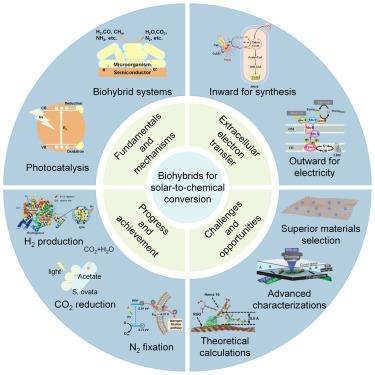Our official English website, www.x-mol.net, welcomes your
feedback! (Note: you will need to create a separate account there.)
Engineering biotic-abiotic hybrid systems for solar-to-chemical conversion
Chem ( IF 19.1 ) Pub Date : 2024-11-20 , DOI: 10.1016/j.chempr.2024.10.018 Wentao Song, Xinyue Zhang, Wanrong Li, Bowen Li, Bin Liu
Chem ( IF 19.1 ) Pub Date : 2024-11-20 , DOI: 10.1016/j.chempr.2024.10.018 Wentao Song, Xinyue Zhang, Wanrong Li, Bowen Li, Bin Liu

|
Constructing biotic-abiotic hybrid systems for solar energy conversion receives growing interest owing to their sustainable and eco-friendly approach to producing chemicals. The integration of intracellular biochemical pathways with semiconductor materials offers superior product selectivity and efficient light utilization in solar-driven biocatalysis. However, the complicated multidisciplinary features and limited understanding of extracellular electron transfer at the biological-material interfaces hinder the practical application of biotic-abiotic hybrid systems for converting solar energy. In this perspective, we summarize the fundamental mechanisms of biohybrid systems for solar-to-chemical conversion and highlight ongoing challenges and promising directions for future development. First, a comprehensive overview of biotic-abiotic hybrid systems is introduced together with the mechanism of extracellular electron transfer for chemical production. Then, recent achievements of biohybrid systems for H2 production, CO2 reduction, N2 fixation, and chemical synthesis are discussed in detail. Finally, the current challenges in biotic-abiotic hybrid systems and prospective research directions are explored.
中文翻译:

设计用于太阳能到化学转化的生物-非生物杂交系统
由于其可持续和环保的化学品生产方法,构建用于太阳能转换的生物-非生物混合系统受到越来越多的关注。细胞内生化途径与半导体材料的整合在太阳能驱动的生物催化中提供了卓越的产品选择性和高效的光利用。然而,复杂的多学科特征和对生物-材料界面处细胞外电子转移的有限理解阻碍了生物-非生物混合系统在转换太阳能方面的实际应用。在这个角度上,我们总结了生物混合系统用于太阳能到化学转化的基本机制,并强调了持续的挑战和未来发展的有希望的方向。首先,全面介绍了生物-非生物杂交系统以及用于化学生产的细胞外电子转移机制。然后,详细讨论了用于 H2 生产、CO2 还原、N2 固定和化学合成的生物杂交系统的最新成果。最后,探讨了生物-非生物杂交系统的当前挑战和前瞻性研究方向。
更新日期:2024-11-20
中文翻译:

设计用于太阳能到化学转化的生物-非生物杂交系统
由于其可持续和环保的化学品生产方法,构建用于太阳能转换的生物-非生物混合系统受到越来越多的关注。细胞内生化途径与半导体材料的整合在太阳能驱动的生物催化中提供了卓越的产品选择性和高效的光利用。然而,复杂的多学科特征和对生物-材料界面处细胞外电子转移的有限理解阻碍了生物-非生物混合系统在转换太阳能方面的实际应用。在这个角度上,我们总结了生物混合系统用于太阳能到化学转化的基本机制,并强调了持续的挑战和未来发展的有希望的方向。首先,全面介绍了生物-非生物杂交系统以及用于化学生产的细胞外电子转移机制。然后,详细讨论了用于 H2 生产、CO2 还原、N2 固定和化学合成的生物杂交系统的最新成果。最后,探讨了生物-非生物杂交系统的当前挑战和前瞻性研究方向。


















































 京公网安备 11010802027423号
京公网安备 11010802027423号